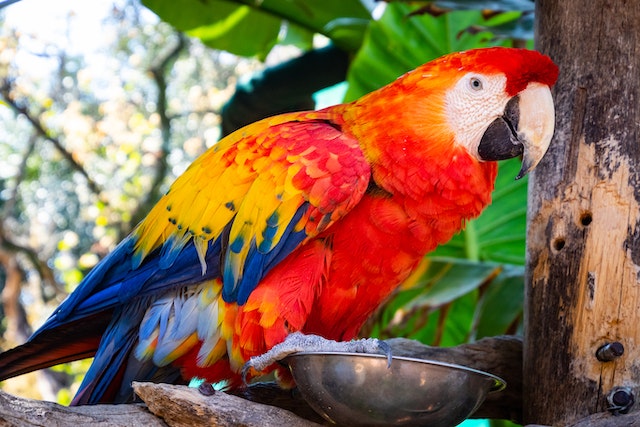
How do parrots talk? They can imitate human speech by passing air across the opening of their trachea using an organ called a syrinx.
Parrots don’t talk in the wild. And when we say “talk”, they mimic human speech without necessarily understanding what they are saying. Some parrots have been taught to learn the names of things and to ask for specific things, but these are the exceptions rather than the norm. Often, parrots merely imitate something they have heard and because it is speech, we attach meaning to it. So, let’s break this topic down into why parrots mimic, what they can say, and how they can do it.
Why do parrots mimic? Nobody has a definitive answer for this, although there are several theories. One theory is that they are born with the ability to mimic other birds in their flocks. Parrots tend to be social animals and they live in groups. This makes life easier for them because there is safety in numbers. Parrots have regional dialects and the cries of one flock will be different to another flock. The ability to mimic helps parrots fit in with their flock. Parrots are different to many other birds in this respect because they have to learn the “language” and aren’t born with it hardwired into their brain.
Another reason could be that the ability to mimic is connected to parrot intelligence. Parrots are very intelligent birds and can problem solve very effectively. They use the part of their brain called the HVC (High Vocal Center), which is the part of a bird’s brain that they use to make song. Parrots have a second layer to this part of their brain that other “regular” birds don’t have. Parrots learn by watching, copying, and remembering. They can pick up numerous skills this way and the ability to mimic sound might just be another one of those skills that they can pick up. They may not mimic sound because it is useful, they may just simply have the ability to mimic many skills.
What can parrots say? In the wild, they communicate using whistles, clicks, and squawks. When they are pets, they copy the sounds they hear most often. They try to copy us because they see us as part of their flock and they see our sounds as the dialect of their new flock. In the wild, parrots can move to a new flock and learn a new dialect. However, in the house, they will copy many sounds that they hear regularly. They might learn to copy a dog barking. If the alarm clock wakes you up and you feed the parrot, they might start imitating the alarm clock to get food. They pick up the words we say the most frequently first because of the repetition. “Hello,” and often swear words are picked up pretty quickly. That doesn’t mean the parrot knows what they mean though. If you often say, “how are you?” when you see the parrot in the morning and it starts to say, “how are you?” when it sees you, it isn’t actually asking you. It has just associated those sounds as a greeting you give each other.
That doesn’t mean that parrots can’t learn if they are trained and not left to learn on their own. In experiments, birds have been taught the words for objects, colors, shapes, and even to count. Parrots have even been known to make new words by connecting words that they already know. For example, a parrot called Alex calls apples “bannery” because they taste a little like banana but look like a cherry.
So, how do parrots talk? We talk by using the air from our lungs to make our vocal chords vibrate, producing sound. We can use our throats, mouths, and tongue to change this sound, making speech. Parrots don’t have vocal chords, movable mouths, or lips, so they have to produce the sound in another way. Parrots have something called a syrinx, which sits at the place where their windpipe connects to their lungs. It is similar to our vocal chords in that it can be made to vibrate. The air comes out of the parrot’s lungs and enters the syrinx. The walls and the folds in the syrinx vibrate, producing sound. However, because the syrinx is at the entrance to the lungs, it has two pipes running into it and air can be pushed into different parts of it simultaneously. We don’t have any control over where the air into our vocal chords goes, but parrots can vibrate only one side at once. It’s possible for parrots to make more than one sound at the same time. This flexible syrinx is the reason why parrots can imitate our voices so exactly. And this is what I learned today.
Sources
https://en.wikipedia.org/wiki/Parrot
https://www.mentalfloss.com/article/73954/why-can-parrots-talk
https://petkeen.com/why-do-parrots-talk/
https://slate.com/technology/2012/11/swearing-parrots-why-do-parrots-mimic-human-speech.html
https://www.audubon.org/news/why-do-parrots-talk
https://www.scientificamerican.com/article/experts-parrots-mimic/
https://en.wikipedia.org/wiki/Syrinx_(bird_anatomy)
